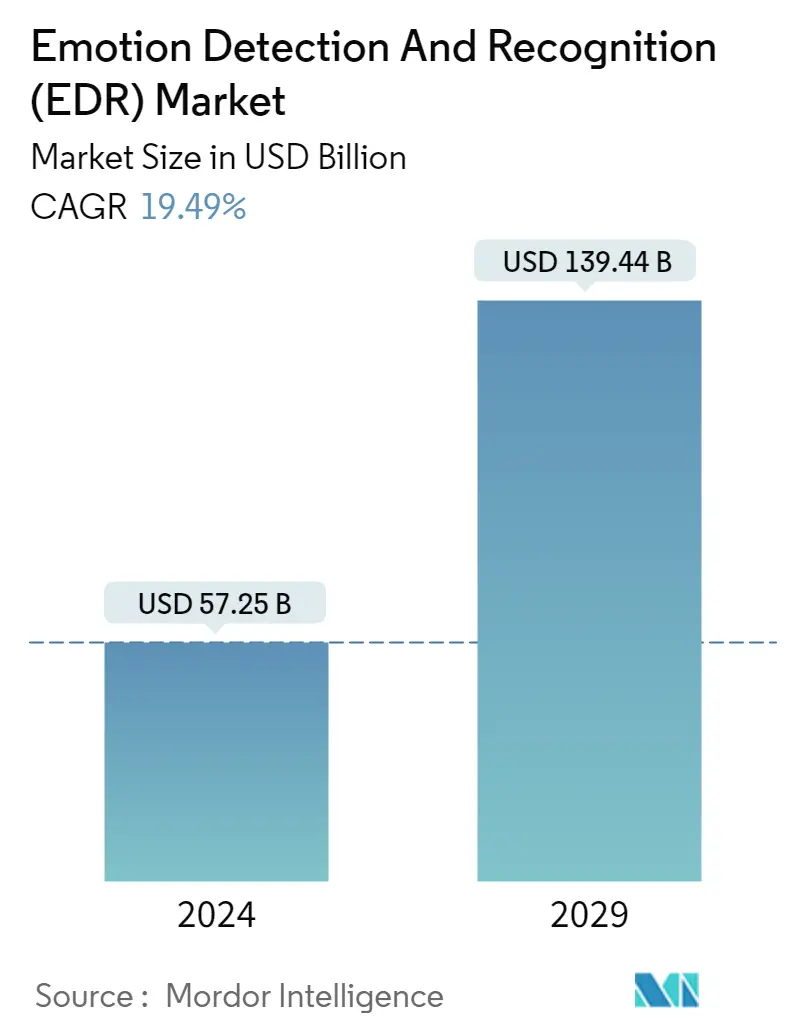Market Size of Emotion Detection And Recognition (EDR) Industry

| Study Period | 2019 - 2029 |
| Market Size (2024) | USD 57.25 Billion |
| Market Size (2029) | USD 139.44 Billion |
| CAGR (2024 - 2029) | 19.49 % |
| Fastest Growing Market | Asia Pacific |
| Largest Market | North America |
Major Players_Market_Major_Players_Logo.webp)
*Disclaimer: Major Players sorted in no particular order |
Need a report that reflects how COVID-19 has impacted this market and its growth?
Emotion Detection and Recognition (EDR) Market Analysis
The Emotion Detection And Recognition Market size is estimated at USD 57.25 billion in 2024, and is expected to reach USD 139.44 billion by 2029, growing at a CAGR of 19.49% during the forecast period (2024-2029).
The Emotion Detection and Recognition (EDR) market is a rapidly growing sector that involves developing and implementing technologies capable of identifying and analyzing human emotions. EDR systems utilize various techniques such as facial expression recognition, speech analysis, physiological signals, and natural language processing to detect and interpret emotional states.
- Businesses increasingly recognize the importance of understanding customer emotions to enhance their products, services, and overall customer experience. EDR technologies enable companies to gather valuable insights by analyzing customer emotions and sentiments.
- The widespread use of wearable devices, such as smartwatches and fitness trackers, has created new opportunities for EDR technology. These devices can collect physiological data, such as heart rate and skin conductance, which can be used in emotion detection algorithms.
- The increasing need for advanced marketing tools drives the Emotion Detection and Recognition (EDR) market significantly. Emotion detection and recognition technology enables marketers to gain deeper insights into customer emotions, sentiments, and preferences. Marketers can understand how customers engage with their brand by analyzing emotional responses to marketing campaigns, advertisements, and product experiences. This data helps create more personalized and targeted marketing strategies, improving customer engagement and conversion rates.
- Emotion detection and recognition systems collect and analyze personal data, including facial expressions, voice recordings, physiological signals, and textual data. The collection and use of such sensitive personal information raise privacy concerns. Individuals are becoming increasingly aware of their data rights and are demanding greater control over their personal information.
- Due to COVID-19, the market is slowdown because wearing masks has become necessary for social engagement, interfering with emotional recognition in everyday life. Furthermore, it hindered detection rates because identification rates were lowest under mask settings, and different emotion types were associated with different parts of the face. Post-pandemic, the market is growing rapidly due to increased connected devices.
